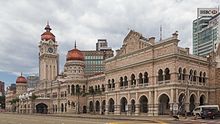Regent Alfred John Bidwell
Regent Alfred John Bidwell (R. A. J. Bidwell) | |
|---|---|
| Born | Regent Alfred John Bidwell 12 June 1869 |
| Died | 6 April 1918 (aged 48) Tanjong Katong, Singapore |
| Nationality | British |
| Occupation | Architect |
| Spouse | Edith Allen (d. 1944) |
Regent Alfred John Bidwell, or R. A. J. Bidwell, was an English-born architect noted for his colonial era buildings in Singapore. His best-known works include the Raffles Hotel and the Victoria Theatre and Concert Hall in Singapore, and Sultan Abdul Samad Building in Kuala Lumpur.
Early life
Regent Alfred John Bidwell was born in 1869. He received his architectural training with Lockyer, Son, & Cox, of London, and he became a member of the Architectural Association, and was placed on the honours list of this institution for design.[1]
Career

Bidwell started work as an assistant to a succession of architects: Crikmay & Son, W. H. Woodroffe of London, and the superintending architect of the London County Council.[1] In 1893 Bidwell left England to go to Malaya after he was nominated for appointment by Sir Charles Gregory to work for the Public Works Department (PWD) of Selangor.
Bidwell was involved in the design of Kuala Lumpur's public buildings and other works, the most important of which is the Sultan Abdul Samad Building.[2] The building was originally designed by A.C. Norman who drew the ground plan with Bidwell designing the elevation in a Classic Renaissance style. However, the State Engineer of Selangor PWD Charles Edwin Spooner disliked the design, and he instructed Bidwell to rework the building in an Indo-Saracenic or Neo-Mughal on Norman's ground plan.[3] Although the building is formally credited to A.C. Norman (and only his name appears on the foundation stone as the architect), the actual appearance of the building is largely the work of R. A. J. Bidwell with contributions from A. B. Hubback who also worked on the building after Bidwell left.[2]
Work in Singapore

In April 1895, Bidwell resigned from the Selangor PWD to join Swan and Maclaren in Singapore. He became a partner of the firm in 1899,[2] and Bidwell designed most of the buildings by Swan and Maclaren during his time at the firm. In 1903 he was elected a fellow of the Surveyors' Institute.[1]
Bidwell designed some of the most significant colonial-era buildings of Singapore such as the Raffles Hotel.
He also helped developed a style of building termed Black and White House which is an adaptation of the traditional English homes that show influences from the Tudorbethan style and Arts and Crafts movement to suit a tropical environment.[4] His design for W. Patchitt House at Cluny Road in 1903 started a trend for building such houses.[5]
Bidwell ceased to be a partner of Swan and Maclaren by 1915, but continued to practice for a few more years.[2] He died on 6 April 1918 in Tanjong Katong after a period of illness.[6]

Notable works

- Sultan Abdul Samad Building, Kuala Lumpur, Malaysia (1897), formally credited to A.C. Norman but much of the design is Bidwell's.
- Atbara House, Singapore (1898), an early Black and White House[7]
- Raffles Hotel, Singapore (1899)
- Goodwood Park Hotel, Singapore (1900)
- Stamford House, Singapore (1904)
- Oriental Telephone and Telegraph offices (1904), the only building of Bidwell in Singapore designed primarily in the Indo-Saracenic style.[8]
- Eden Hall, Singapore (1904)[9]
- Chesed-El Synagogue, Singapore (1905)
- Singapore Cricket Club (1907), Bidwell designed the extension that projected out from the main clubhouse in two sections facing the pitch.[10]
- Telephone House, Robinson Road (1907), opposite Lau Pa Sat,[11] currently SO Sofitel Singapore hotel.
- Victoria Theatre and Concert Hall, Singapore (1909), renovation of Town Hall (Victoria Theatre) to harmonise with Victoria Memorial Hall.[12]
- Hotel Majapahit, Surabaya, Indonesia (1911)
- Butterfly House (Cashin Mansion), Singapore (1912)[13]
References
- ^ a b c Wright, Arnold (1908). Twentieth century impressions of British Malaya: its history, people, commerce, industries, and resources. Lloyd's Greater Britain Publishing Company, limited. p. 627.
- ^ a b c d Gullick, J.M. (1992). "The Bangunan Sultan Abdul Samad". Journal of the Malaysian Branch of the Royal Asiatic Society. 65 (1): 27–38. JSTOR 41493197.
- ^ "Sultan Abdul Samad Building". Pusat Pengajian Seni, Universiti Sains Malaysia. Archived from the original on 11 July 2015. Retrieved 21 July 2016.
- ^ The French in Singapore: An Illustrated History (1819-today). Editions Didier Millet. 16 May 2012. pp. 139–140. ISBN 978-9814260442.
{{cite book}}: Unknown parameter|authors=ignored (help) - ^ "Black and White Houses in Singapore". Roots.
- ^ "Death of Mr. R. A. J. Bidwell". The Straits Times. 8 April 1918. p. 8.
- ^ "Atbara House". Remember Singapore.
- ^ Metcalf, Thomas R. (24 April 2007). Imperial Connections: India in the Indian Ocean Arena, 1860-1920. University of California Press. pp. 60–61. ISBN 9780520258051.
- ^ Peterson, Jane A (11 September 2014). "A Slice of British Colonialism in Singapore". The New York Times.
- ^ Jane Beamish; Jane Ferguson (1 December 1985). A History of Singapore Architecture: The Making of a City. Graham Brash (Pte.) Ltd. pp. 90–91. ISBN 978-9971947972.
- ^ Jane Beamish; Jane Ferguson (1 December 1985). A History of Singapore Architecture: The Making of a City. Graham Brash (Pte.) Ltd. pp. 91–92. ISBN 978-9971947972.
- ^ Susan Tsang (2008). Discover Singapore: The City's History & Culture Redefined. Marshall Cavendish International (Asia) Pte Ltd. p. 202. ISBN 978-9812613653.
- ^ "Butterfly House : general view". National Library Board Singapore.
